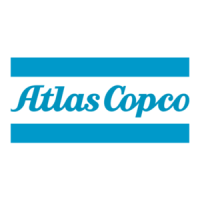2920 1390 02
14
Instruction book
3.3 During operation
Regularly check:
1. Pressure dewpoint indicator (1-Figs. 3.1 and 3.2). 1)
2. That condensate is discharged (4-Fig. 2.5). The amount
depends on the operating conditions.
3. Regularly open manual drain valve (2-Fig. 2.5) for approx.
10 seconds to discharge condensate and possible impurities.
3.4 Stopping (Figs. 3.1 and 3.2)
1. Close the dryer inlet and outlet valves (customer's
installation).
2. Press on-off button (S1). The dryer stops. Voltage on lamp
(H1) remains alight. On FD170 and FD230, the crankcase
heater remains switched on. Leave the voltage on if the
dryer has to remain stand-by.
4 MAINTENANCE
Cooling dryers of FD type contain refrigerant HFC.
Safety precautions
When handling refrigerant R404a, all applicable safety
precautions must be observed. The following points are
stressed:
- Contact of refrigerant with the skin will cause freezing.
Special gloves must be worn and in case of contact, the
skin should be rinsed with water. On no account may
clothing be removed.
- Fluid refrigerant will also cause freezing of the eyes;
therefore, safety glasses are a must.
- Refrigerant R404a is poisonous. Do not inhale refrigerant
vapours. Check that the working area is adequately
ventilated.
Local legislation may impose that:
- work in the refrigerant circuit of the cooling dryer or on
any equipment which influences its function should
according to the law be executed by an authorized control
body.
- the installation should according to the law be checked once
a year by an authorized control body.
General
- Keep the dryer clean.
- Brush or blow off the finned surface of condenser (2-Fig.
1.1) regularly.
- Once every six months inspect and clean the inner
components of condensate trap (3-Fig. 2.6).
5 SETTINGS
The regulating and safety devices are factory-adjusted to obtain
optimum performance of the dryer. Do not alter the setting of
any of the devices.
6 PROBLEM SOLVING (Fig. 1.2)
1. Pressure dewpoint too high
a. Air inlet temperature too high
a. Check and correct; if necessary, install a pre-cooler
b. Ambient temperature too high
b. Check and correct; if necessary, draw cooling air via a duct
from a cooler place or relocate dryer
c. Air inlet pressure too low
c. Increase inlet pressure
d. Dryer capacity exceeded
d. Reduce air flow
e. Shortage of refrigerant
e. Have circuit checked for leaks and recharged
f. Refrigerant compressor (M1) does not run
f. See 3
g. Evaporator pressure too high
g. See 6
h. Condenser pressure too high
h. See 2
2. Condenser pressure too high or too low
a. Fan control switch (S3) out of order
a. Replace
b. Fan or fan motor out of order
b. Check fan/fan motor
c. Ambient temperature too high
c. Check and correct; if necessary, draw cooling air via a duct
from a cooler place or relocate dryer
d. Condenser externally clogged
d. Clean condenser
3. Compressor stops or does not start
a. Electric power supply to compressor is interrupted
a. Check and correct as necessary
b. Thermic protection of refrigerant compressor motor (M1)
has tripped
b. Motor will restart when motor windings have cooled down
4. Condensate trap remains inoperative
a. Automatic drain system clogged
a. Flush the assembly by opening manual drain valve. Have
system inspected
Footnote chapter 3
1) The pressure dewpoint will deviate from nominal if the air inlet conditions or volume flow differ from nominal.

